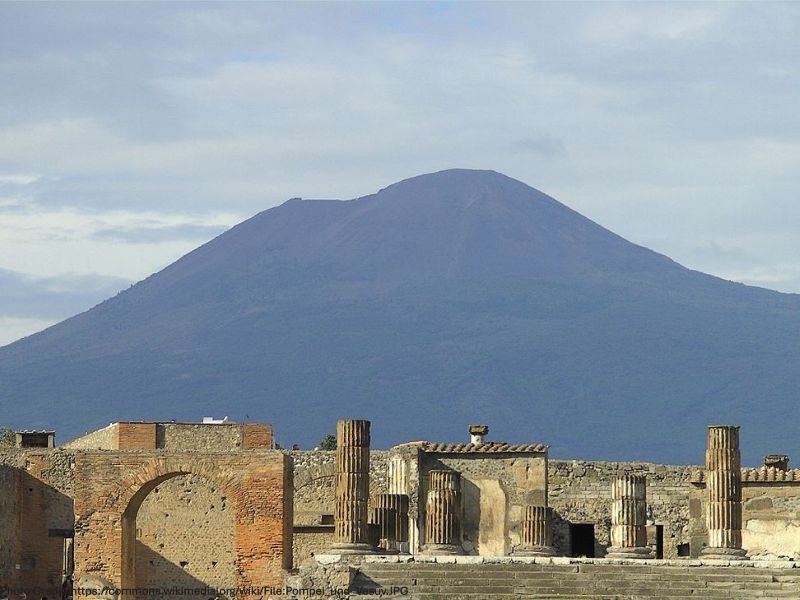Pompeii, the legendary ancient Roman city buried under volcanic ash from the eruption of Mount Vesuvius in 79 AD, offers a unique and fascinating glimpse into life as it was nearly two thousand years ago. Today, Pompeii is one of the most important archaeological sites in the world, drawing millions of visitors eager to explore its ruins and uncover the stories frozen in time. Join us as we take a deep dive into Pompeii’s rich history, its preservation, and the must-see attractions on a visit to this extraordinary UNESCO World Heritage site.
The History of Pompeii: A City Frozen in Time
Pompeii was once a thriving Roman city located near the Bay of Naples in southern Italy. Established in the 7th or 6th century BC, it quickly grew into a bustling urban center, known for its commerce, luxury, and stunning architecture. The city had a population of around 20,000 people at its peak, with grand houses, shops, bathhouses, and entertainment venues like theaters and amphitheaters.
However, on August 24, 79 AD, the eruption of Mount Vesuvius dramatically changed Pompeii’s fate. The eruption covered the city in a thick blanket of ash and pumice, burying it and its inhabitants under layers of volcanic material. The event was so sudden that many people were trapped in their homes and workplaces, unable to escape. For centuries, Pompeii lay forgotten, hidden beneath the ash, until it was rediscovered in the 18th century.
Today, Pompeii remains an extraordinary testament to the life of its inhabitants, as the volcanic ash preserved buildings, frescoes, mosaics, and even the remains of people, offering unparalleled insights into ancient Roman life.
What to See in Pompeii: Key Attractions and Highlights
A visit to Pompeii is like stepping back in time. The city is filled with well-preserved ruins that allow visitors to imagine daily life in the Roman Empire. Here are some of the most important and fascinating sights to explore during your visit:
1. The Forum
The Forum was the central public space of Pompeii, used for markets, social gatherings, and political events. Surrounded by temples, government buildings, and shops, the Forum offers an excellent view of the city and provides context for understanding the role of public life in ancient Roman society.
2. The House of the Faun
One of the most impressive residences in Pompeii, the House of the Faun is a large, luxurious home with stunning frescoes and intricate mosaics. Its name comes from a statue of a dancing faun found on the property. The house is famous for its grand design and its connection to the elite class of Roman society.
3. The Amphitheater
The Amphitheater of Pompeii is one of the oldest surviving Roman amphitheaters and could hold up to 20,000 spectators. This venue was used for gladiator fights, animal hunts, and public spectacles, making it a key piece of Pompeii’s entertainment culture. It’s also one of the best-preserved amphitheaters in the world.
4. The Villa of the Mysteries
This well-preserved villa is known for its stunning frescoes depicting the mysterious Dionysian rites, which are believed to represent initiation into the cult of Dionysus. The vibrant colors and intricate details make this villa a must-see for art and history lovers alike.
5. The Lupanar (Brothel)
One of the most unique and eye-opening sites in Pompeii is the Lupanar, a brothel with erotic frescoes that illustrate the services offered. It provides a rare and candid insight into the social customs and private lives of the ancient Romans, highlighting the human side of the ancient city.
6. The Garden of the Fugitives
One of the most haunting areas of Pompeii is the Garden of the Fugitives, where plaster casts of victims caught in the eruption can be seen. These casts, made by filling the voids left in the ash by the bodies of the victims, offer a poignant and powerful reminder of the tragedy that befell Pompeii’s residents.
The Preservation of Pompeii: A Historical Treasure
The preservation of Pompeii is nothing short of miraculous. When Mount Vesuvius erupted, it buried the city under approximately 13 to 20 feet of ash and pumice, which ultimately preserved much of the city’s architecture, art, and even the remains of its inhabitants. Excavations began in the 18th century and have continued ever since, with archaeologists uncovering an astonishing array of artifacts and structures.
One of the most remarkable aspects of Pompeii’s preservation is the frescoes and mosaics that adorn many of its buildings. These intricate works of art depict everything from gods and goddesses to everyday life, providing a window into the culture and beliefs of the ancient Romans.
Additionally, Pompeii’s public and private buildings are remarkably well-preserved, giving visitors a unique opportunity to see how Roman cities were laid out, how homes were decorated, and how the residents lived.
Pompeii Today: A UNESCO World Heritage Site
In 1997, Pompeii was declared a UNESCO World Heritage site, cementing its status as one of the most important archaeological sites in the world. The ongoing excavation and preservation efforts at Pompeii are crucial to ensuring that this ancient city continues to inspire future generations of visitors.
Visitors to Pompeii today can explore the site on guided tours, or wander through the ruins on their own, immersing themselves in the history that lies within. The site is open year-round and offers an unparalleled chance to experience the life of an ancient Roman city as it existed nearly 2,000 years ago.
Ready to Step Into Ancient History?
Don’t just read about it—experience Pompeii for yourself! Walk the ancient streets, explore the remarkably preserved ruins, and witness the power of Mount Vesuvius up close.
👉 Book your guided Pompeii tour today for an unforgettable journey into the past.
